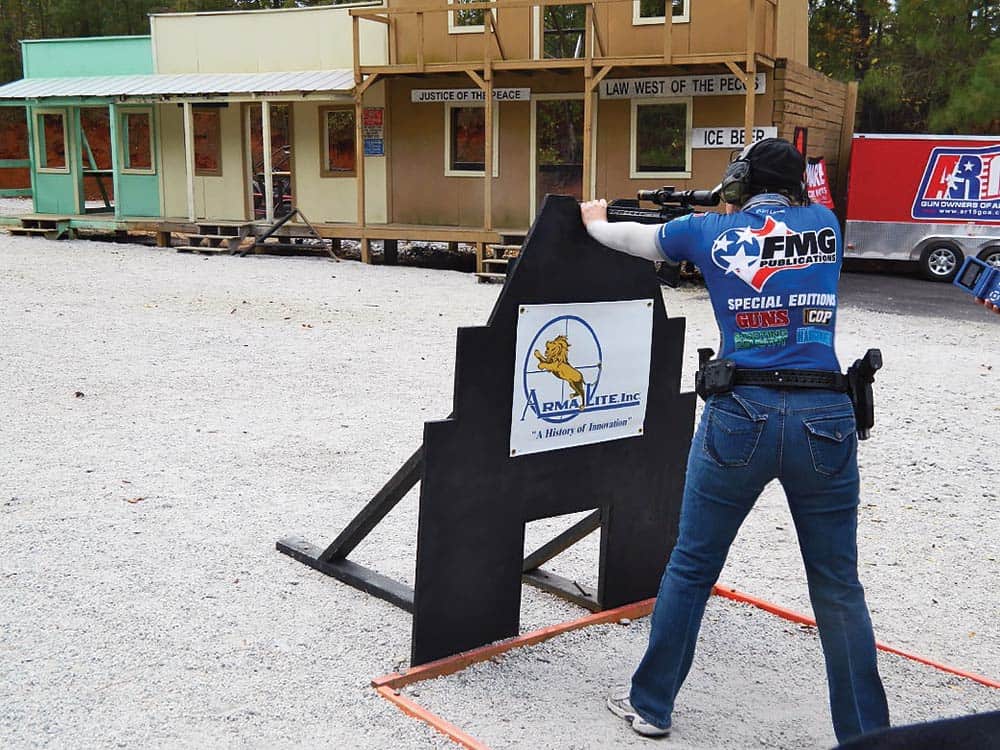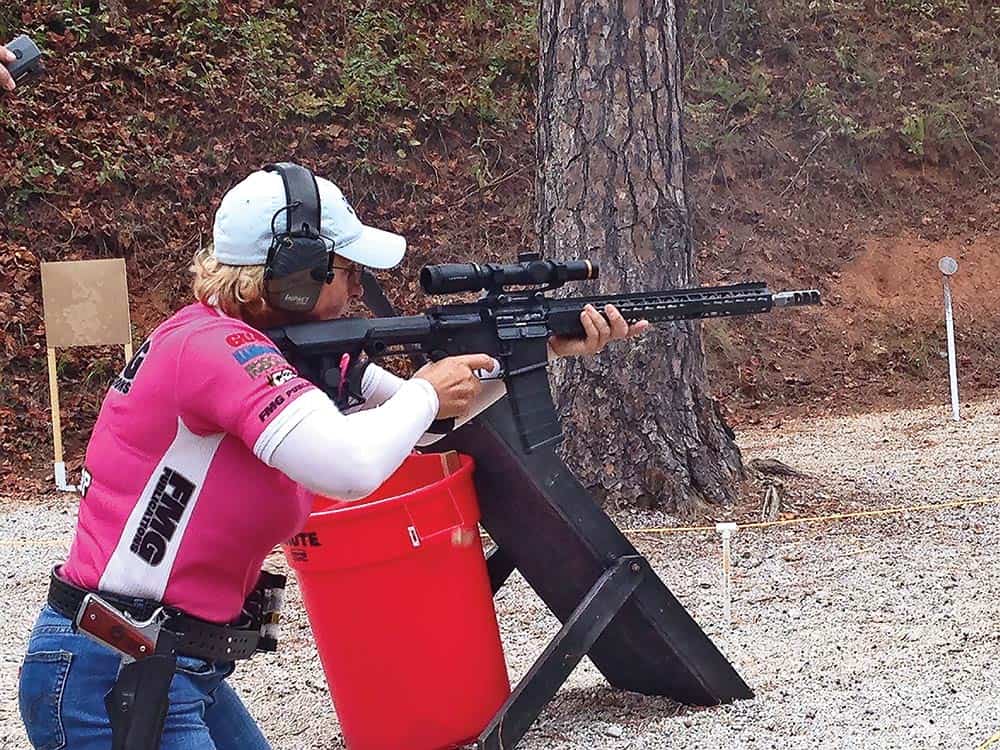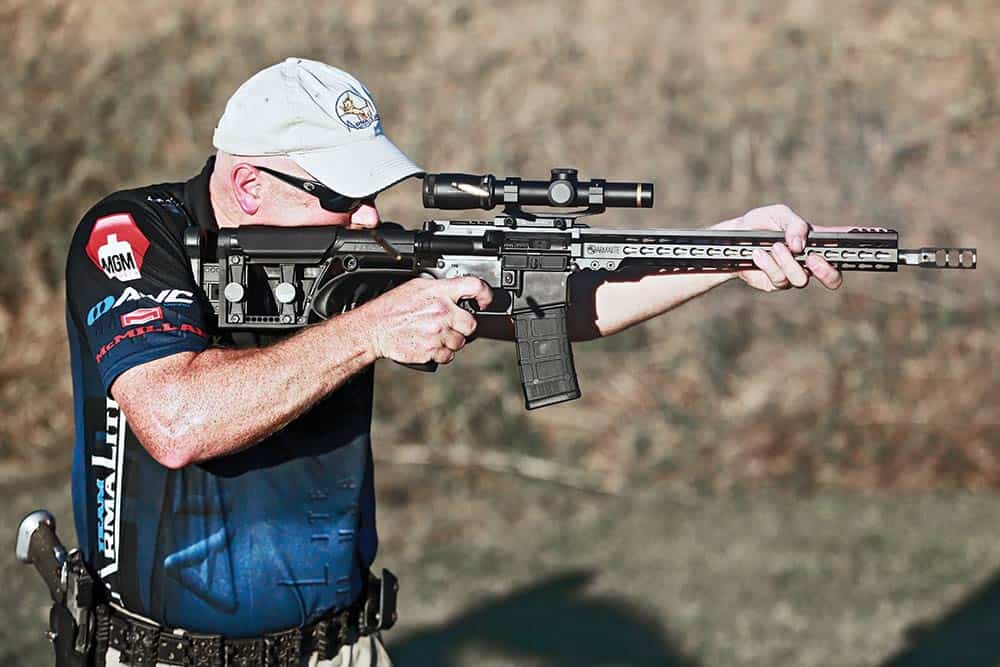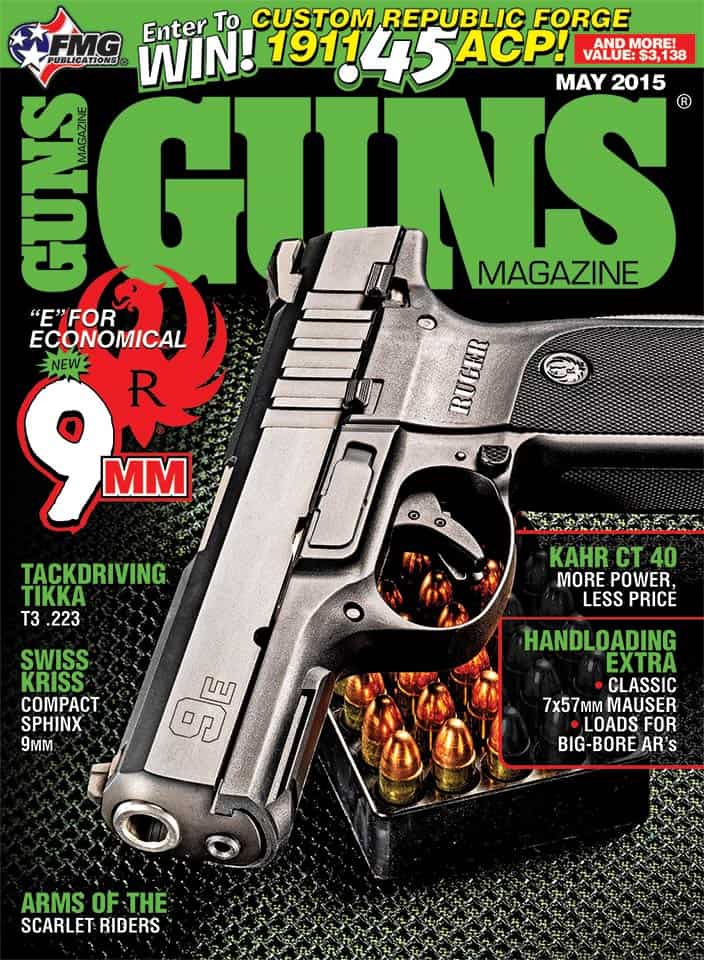Dissecting the 3-Gun Game & Equipment Part 2
The Rifle
Shari shoots a stage at the Brownell’s Lady 3-Gun Match with shooting the Armalite M-15 3GN in supported position.
For someone like me, who has spent their entire shooting sports career shooting games with very defined guidelines, rules, regulations and governing federations, 3-Gun is a test of my patience and frustration level. I’m not saying I don’t like the game. On the contrary, I love it and enjoy shooting it every chance I get.
But why this game is so complicated to dissect and explain is because unlike the other shooting sports where there are governing bodies to administer things, 3-Gun has no single entity to manage and coordinate the rules and events. A couple of organizations have taken the lead, such as the United States Practical Pistol Association (USPSA) and the International Multi-Gun Association (IMGA), but even those two groups vary in their definitions and guidelines. However, the lack of a governing body hasn’t hindered the growth of the sport and there are many organizations, groups and gun clubs hosting 3-Gun matches. As a result, the rules for this game vary from competition to competition, with each event host applying their own rules.
The good news is there are some central factors, such as the divisions or categories a shooter wishes to shoot in, but even those have slight variations from group to group and range to range. But breaking down the divisions is a start to determine the guns and gear needed. Keep in mind, these are the very basic fundamentals for the 3-Gun divisions and I recommend checking with the organization hosting the match.
The M-15 3GN rifle easily get on target and stays on target in an unsupported position.
3-Gun Divisions
Open: Optics are allowed on all three firearms with unlimited rounds in the magazines. Compensators and porting are allowed on the shotguns and rifles. There are almost no restrictions in this division.
Limited: Only the rifle is allowed optics with only one optic allowed and it can’t be magnified (iron sights or red dot). The shotgun can be a semi-auto or pump action and there is an 8+1-round maximum limit with no detachable magazine. The handgun can have no optics or porting and the magazine can’t exceed 141.25mm.
Tactical: Has the same requirements as Limited, except the rifle optic can be magnified.
Heavy Metal: Aptly named, as this is the large caliber division. The rifle must be 7.62×51 or larger with only iron sights. The handgun must be .45 ACP or larger with no optics or porting. The shotgun must be a 12-gauge pump-action with iron sights and no porting.
In gets a little more confusing after the basics, as there are categories within divisions. For example, in Tactical there’s Tactical Optics and Tactical Irons. In Heavy Metal, there’s Heavy Optics and Heavy Irons. Some groups have only three divisions. So, before jumping into the 3-Gun game and buying equipment, be sure to research thoroughly the divisions and organizations you’re shooting in.
Once you decide what division to shoot in, what match and what organization, get a copy of the rules. The rules for 3-Gun matches vary from competition to competition, so I suggest going to the club or organization hosting the match for the rules. And finally, watch a match. Get a feel for how things take place.
There are multiple stages in 3-Gun competition with each stage being held on different bays. The number of stages depends on the match organizer. Again, there is no pre-set number, but the stages will combine rifle, pistol and shotgun. But having said that, all three firearms are not always used in every stage. A stage could use only the pistol and shotgun or the rifle and shotgun or any other combination of firearms. But one thing is guaranteed. All the stages are completely different. The only consistent format is the targets will be a combination of steel and paper and, in some cases, moving clay targets.
Combining how fast you complete a stage and how many hits you have determines your final score for that stage. However, in this sport, time is added to your final score as a penalty. Penalties are not “engaging” a target, meaning it was never shot at or missed completely, hitting a no-hit target, which is usually a white cardboard cutout and is typically placed at a very strategic angle close to the target you need to hit. And lastly, hitting a target, but not in the defined area. All this adds to your score for that stage. Then, all the stage scores are combined for a total score, which determines your overall placement in the competition. Check the rules of that match for scoring procedures as like everything else in 3-Gun, they vary from match to match.
So, you’re probably thinking, I’ll take my time and be sure to hit all the targets, but shooting slow and methodically will take time and add to the score. Conversely, just throwing rounds down range and not hitting targets adds to the score as well. Finding that happy medium between fast and accurate is what makes a successful 3-Gun shooter.
Tommy Thacker, 2011-2012 3-Gun National Champion, now President of Armalite, Inc. was instrumental in the design of Armalite’s new M-15 3GN competition rifle.
The Rifle
Stages vary in 3-Gun competition. Sometimes you’re standing or kneeling in one place shooting at multiple targets, or you’re running and gunning. A light, fast and compact rifle is essential. The most commonly used rifle used in 3-Gun is the .223 AR-15 in the Open and Tactical divisions and the .308 AR-10 or M1A for the Heavy Metal division. I decided to try Armalite’s new .223 M-15 3GN competition rifle for my first foray into 3-Gun.
Very seldom am I lucky enough to pick up a long gun right out of the box and be able shoot it without a lot of adjustments. The M-15 3GN was such a gun. At 6.9 pounds without the scope, it’s a very manageable weight and is well-balanced rifle for speed and accuracy.
Light guns are easily over controlled and can be whipped around, particularly if they’re not well balanced. Though the M-15 3GN is light, I was able to get on target quickly and stay on target even in unsupported positions because the gun is so well balanced. And for a lightweight .223, there was minimal felt recoil. Granted, part of that could have been I was in a match, adrenaline was high and I wasn’t really focused on feeling recoil. But there have been many instances with a shotgun where every shot felt as if I’d been kicked by a mule.
This gun is designed for competition and Armalite did an outstanding job in balancing the weight of the gun with its capabilities. Tommy Thacker, President of Armalite is a former 3-Gun shooter and a National Champion of the sport. There’s no doubt he spent time with the Armalite designers making the M-15 3GN exactly right. Knowing what’s needed from a gun during competition, knowing the abuse it will take and knowing how shooters will treat it makes all the difference in the design.
As a shotgun shooter, I am comfortable with long guns, and I even became comfortable running/moving with a loaded firearm, but I was very uncomfortable throwing it into a big plastic trashcan, which is required in 3-Gun competition. Taking any gun and aggressively dropping it or tossing it into a barrel is just flat against my nature.
One very important thing to mention when it comes to shooting any 3-Gun event is safety is paramount —the Number One priority of everyone. Because this is a run-and-gun game where people are moving as fast as possible with a loaded firearm, everyone from range officers to competitors to spectators are very cognizant of where their gun is pointed and the position of their body in relation to the targets engaged. Safety is constantly emphasized and enforced.
Which brings up another aspect of 3-Gun competition. You will eventually be disqualified for a safety violation. It happens to everyone I’m told, experienced pros and novice shooters alike. Usually for not putting the gun on “safe” after dropping it into the barrel or “sweeping” during a course of fire. Nothing to be ashamed of I’m told. Sitting around telling the story of how you were disqualified is a rite of passage. I haven’t been disqualified yet, but I’ll keep you posted.
The many variances and lack of strict conformity has contributed to 3-Gun competition’s popularity, and the game is definitely an adrenaline rush. As exciting and thrilling as it is to shoot it, it’s also an exercise in patience to understand all the nuances, but in the end… it’s well worth it.
M-15 3GN
Maker: ArmaLite, Inc.
P.O. Box 299
Geneseo, IL. 61254
(309) 944-6939
https://gunsmagazine.com/company/armalite-inc/
Action: Semi-auto,
Caliber: 5.56mm, .223,
Magazine: 30-round Magpul PMAG,
Overall Length: 34.5 to 35.5 inches,
Weight: 6.9 pounds,
Barrel: 18 inches, stainless steel,
Rifling Twist: 1:8-inch,
Muzzle Device: Armalite Tunable Brake,
Upper Receiver: Forged, 7075-T6 aluminum flat-top, M1913 rail,
Lower Receiver: Forged 7075-T6 aluminum,
Finish: Anodized aluminum upper/lower receiver, manganese phosphated steel barrel,
Stock: MBA-1 Lightweight, adjustable for length of pull and comb height,
Handguard: 15-inch aluminum key-mod,
Charging Handle: Raptor ambidextrous,
Trigger: Timney 3-pound single-stage,
Price: $1,599






